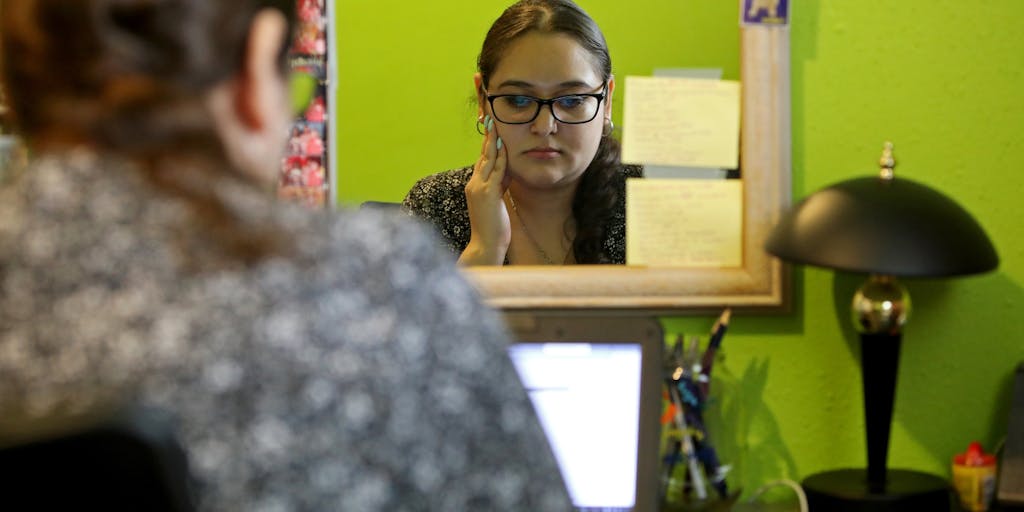
What should teenagers do after high school?
With rising college tuition expenses and overwhelming student loan debt, there’s a debate underway about whether college or job training is the right path for young people who face financial barriers and other challenges.
But educators, policymakers and employers who are busy redesigning postsecondary options don’t always understand what teenagers actually need and want. If they listened, what would they learn?
The short answer is: Young people want more than good livelihoods. They want good lives.
That’s what EdSurge found out by talking at length with nine diverse high school students from around the U.S. in 2021 about the lives they’re working toward and the choices they’re making to get there. Read profiles, see portraits and listen to the voices of those students here.
Then keep reading below to learn how these teenagers’ lives have changed during the past year.
Dino Sabic

During his senior year of high school, Dino Sabic of Chattanooga, Tennessee, was feeling stressed about the pandemic and disappointed about his interrupted football seasons. He was considering studying business in college, having started to reconsider his previous goal of working in medicine.
After graduating in spring 2021, Dino enrolled at the University of Tennessee at Chattanooga, where he now studies. He also continues to work part-time at a logistics company.
“I love it so far!” Dino reports. “Awesome school and awesome job!”
Vernell Cheneau III

Budding businessman Vernell Cheneau III had decided against going to college by the time he graduated from high school in spring 2021. Instead, the New Orleans resident was excited to start a job in the human resources department of a Fortune 500 energy company.
Vernell says he has been doing great work at Entergy ever since. He is expecting a raise soon and says his manager requested that Vernell continue to work in her department because he is such an “asset.”
Over the past year, Vernell has stopped his side business of reselling phone cases. Now he has a new enterprise: selling T-shirts through a website called Villain Headquarters.
“Long story short,” Vernell says, “life has been great for me.”
Spencer Risenmay

As a member of a farming family in Idaho Falls, Idaho, Spencer Risenmay planned to pursue a college degree in agribusiness to learn about the scientific innovations shaping agriculture. But before enrolling in higher education, Spencer planned to complete a two-year mission for The Church of Jesus Christ of Latter-day Saints.
After graduating from high school in spring 2021, Spencer embarked on that church mission. He is currently serving in Ghana, according to one of his former teachers.
Efiotu Jagun

With her strong math skills, plus family members with science-focused careers, Efiotu Jagun once considered studying engineering in college. She even won a scholarship to Georgia Tech.
But by her senior year of high school in Durham, North Carolina, she had realized that she wanted to explore other interests and activities instead. She wondered whether it made sense to enroll at the technology powerhouse of a university.
Efiotu ended up starting college at Georgia Tech, and she says, “It’s pretty good so far!” She’s studying public policy and sociology there, in addition to playing Ultimate Frisbee, starting a chapter of a student-advocacy organization and interning at the Georgia General Assembly for the 2022 legislative session.
Princesa Ceballos

College is still on the horizon for Princesa Ceballos, a busy high school student from Porterville, California, who divides her time playing tennis matches, raising livestock, leading clubs and doing community service.
Princesa says she has been accepted to four universities so far: California State University at Fresno, California State University at Chico, California State University at Pomona and University of California at Berkeley. Berkeley offered to cover most of her tuition, she says, as well as invited her to be a Regents’ scholar. Right now Princesa hopes to study agriculture and environmental plant sciences in order to become a pest control advisor.
In between working on college applications, she has lately enjoyed traveling beyond her town in the San Joaquin Valley. Recently, Princesa mentioned that “I’m going to be in Sacramento for a conference all week and I’m very excited about that.”
Maytee Guadiana

Leading up to her high school graduation, Maytee Guadiana looked forward to going to college, in order to continue learning and to study to become a nurse. That was her profession of choice because of the opportunities it would give her to help others.
But Maytee, who lives in San Antonio, also worried about being able to finish college. Years earlier, her mother hadn’t been able to afford to complete her degree.
In the past year, Maytee enrolled at Texas A&M University at San Antonio and says she’s staying focused on school.
Kaiasia Williams

Despite her clear career goals and academic success in high school, Kaiasia Williams was worried about going to college. She wondered whether she could stay motivated, avoid procrastinating and remain confident in her abilities.
In spring 2021, Kaiasia became the first person in her family to graduate from high school. She has since started college at Clemson University, where she’s studying engineering. “College has me running in circles,” she reports.
To help get her there, Kaiasia received a $10,000 scholarship gift from a couple who also live in Charleston, South Carolina, as well as a $20,000 CMiC-Allen Berg Memorial Scholarship from the Architecture, Construction, and Engineering Mentor Program of America.
“The scholarships I won was enough to get me through the doors,” Kaiasia says, “and I am truly thankful.”
Alan Farfan

When Alan Farfan thought ahead to life after high school, he named career stability as a big personal priority. And the student from Austin, Texas, wasn’t convinced that a college degree was the best way to land a reliable job.
Alan is now a high school junior taking some college-level courses, including in UX Design. This summer, he plans to intern at IBM. And according to one of his teachers, Alan has started working at Whataburger, a job he is enjoying.
Freddy Zepeda

As a senior in high school, Chicago student Freddy Zepeda hoped to come out of college ready to find a job that interests him and that helps him build the good life that his family envisions.
After graduating in 2021, he enrolled at the University of Illinois Chicago, where he is studying earth and environmental science. He says he has been doing very well there. Thanks to credits Freddy earned while dually enrolled in high school and community college, the university considers him to be a junior, and he has fulfilled many of the requirements for his major.
Freddy says he is now focusing on applying for summer internships while keeping up with his coursework.
What can we learn from teenagers?
Adults building new pathways through college or job-training programs need better insight about where young people ultimately want to end up. That information comes from listening to teenagers.
“You want to know, for starters, what a young person’s work interests are, what their work values are, what do they want to get out of work?” says Anthony Carnevale, director of the Georgetown University Center on Education and the Workforce.
By listening to these nine teenagers, EdSurge learned several key lessons. Young people’s brains are wired for passion, purpose and experimentation. Even though some of them face significant barriers to success after high school, they tend to lean more into their potential than into their limits. They trust their families, friends and teachers to guide them. And some teenagers are skeptical about the value of college, but plenty still see higher education as the best option for meeting their goals.
These insights can help educators, policymakers and employers better design programs for young people.
“The more engagement and ownership young people have in the entire thing,” says Allison Gerber, director of employment, education and training at the Annie E. Casey Foundation, “the more likely it will meet their needs, they’ll want to stay, feel a sense of belonging, and it will be attractive to them and their peers.”